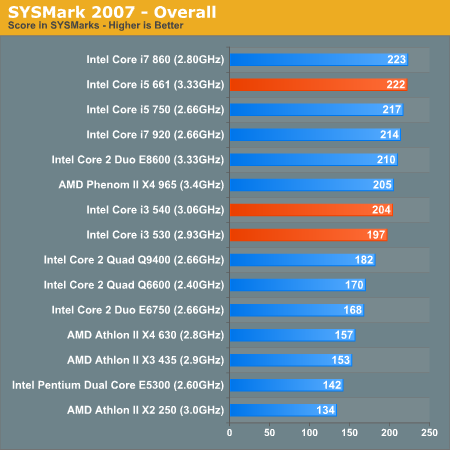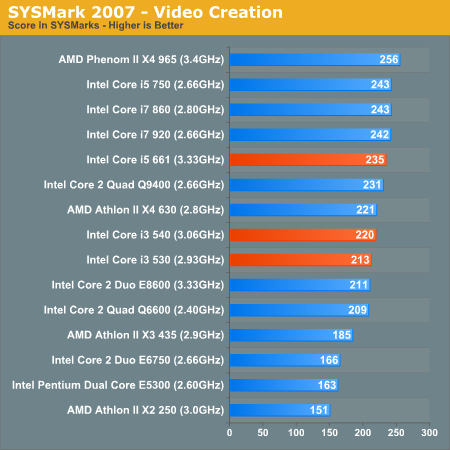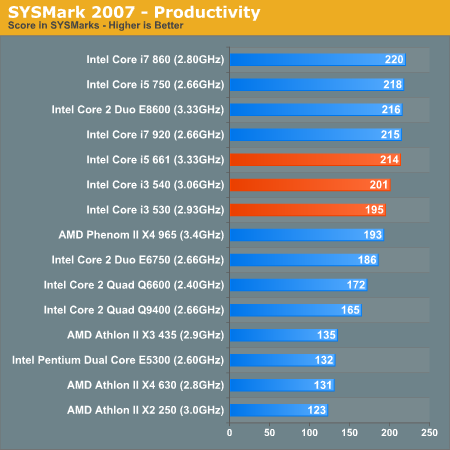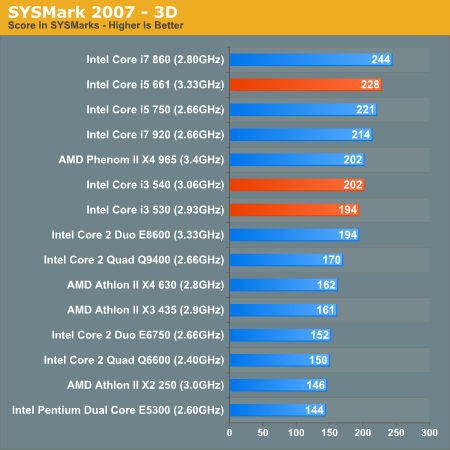The Clarkdale Review: Intel's Core i5 661, i3 540 & i3 530
by Anand Lal Shimpi on January 4, 2010 12:00 AM EST- Posted in
- CPUs
SYSMark 2007 Performance
Our journey starts with SYSMark 2007, the only all-encompassing performance suite in our review today. The idea here is simple: one benchmark to indicate the overall performance of your machine.

SYSMark performance is a strong point of the new Clarkdale family. The Core i5 661 is able to deliver overall performance roughly equivalent to the Core i7 860. If you aren't running heavily threaded code that can really stress all four cores of a Lynnfield or Phenom II, the Core i5 661 is going to perform very similarly.
The real winners however are the simulated Core i3 540 and 530. You give up Turbo Boost but you still maintain Hyper Threading, which delivers Phenom II X4 965 performance for $133. Obviously AMD will still win in most tasks that stress all four cores, but for the majority of users you'll actually have roughly the same performance out of an i3 530. Impressive.
These Clarkdale chips are also a significant performance improvement over the older Core 2 based products. The i3 530 looks to be around 17% faster than the Conroe based Core 2 Duo E6750. Even AMD's value quad-core chips can't compete here, but that's just because we're not really stressing all four threads.














93 Comments
View All Comments
Paladin1211 - Monday, January 4, 2010 - link
On page 13, in WoW benchmark, the Core i5 750 outperforms the Core i7 870 by more than 30% (92.3 fps vs 70.6 fps). Anything wrong here?Crimson67 - Tuesday, January 5, 2010 - link
WoW doesn't seem to like hyperthreading, it's the only explanationereavis - Wednesday, January 6, 2010 - link
is it using the hyperthread core on the 870 but a true core on the 750? That would certainly slow it down. If it's using a true core on both it should be better still.Dyzios - Monday, January 4, 2010 - link
Remember NVIDIA Hybrid idea, to have two GPUs ? - one weak for 2D/light 3D graphics and powerful discrete GPU for gaming? Those CPU makes sense for this approach - however Radeon 5870 also has good point with optimized low idle power consumption. Maybe still there is point as even Radeon cannot go very low as GPU on-die. The only question is to have capability to switch HDMI output between on-die GPU and discrete.I wonder how this works currently - still needed to stick to DVI output from Radeon or can be combined?Zool - Tuesday, January 5, 2010 - link
If the 40nm 5600 series cards will show the same improvments in power usage than the 5800 series than u can forget the intels GMA graphic.I think that for a 2D card/3D discret card u can buy a mobo with a dirty cheap intel GMA on it clocked much lower if u realy need.
silverblue - Wednesday, January 6, 2010 - link
The graphics comparison isn't exactly fair but in the end, it's not something AMD should be too worried about. The i5-661, with its 900MHz 45nm GPU, is being compared to the old 790GX's HD 3300 which operates at 700MHz on a 55nm process. I admit, in the benchmarks we're talking the best i5 vs. the best AMD has to offer, but considering...a) the relative performance of the i5-750 as compared to the PII X4 965 which is usually manifested as an advantage
b) the fact that the 32nm i5s can increase their core speed by 133MHz and 266MHz thanks to Turbo depending on the number of active cores
c) most games still aren't designed to take full advantage of multithreading so four cores may not yield a tangible performance increase
...then AMD's still in the lead for IGPs. If the 3300 had been clocked at 900MHz, would it have lost even one of the listed benchmarks? I'm not sure it would have. What's more, we're still talking a 55nm part; we all know of TSMC's issues with the 40nm process and AMD going fablress, so is it unreasonable to expect that AMD could move their IGP production en masse to 40nm with TSMC or 45nm with GlobalFoundries?
In closing, it's a big step forward for Intel, however if AMD came out with a higher clocked 40/45nm IGP then, Sideport or not, new tech or not, AMD would be far ahead, at least on gaming terms. Sideport does very little for the performance of current AMD IGPs, anyway.
I just wish AMD were able to release a Clarkdale competitor sooner rather than later.
ruetheday - Friday, January 8, 2010 - link
the IGP on Clarkdale isn't maxed out at 900Mhz; It too can be overclocked significantly. Here's an article on techgage showing an OC to 1133, for example.Remember that Intel is very conservative on binning parts to ensure no issues with reliability over time (compare vs nvidia mobile gpus).
silverblue - Friday, January 8, 2010 - link
Maybe so, however a 40/45nm AMD part could reach similar clockspeeds. I just don't think that, clock for clock, the new Intel IGP on the Clarkdale die is as powerful as anything AMD or nVidia can produce on the same scale. It's a good step forwards, just not the leadership that some may have been expecting.silverblue - Wednesday, January 6, 2010 - link
Slight mistake... second best 32nm i5 that Intel has to offer. However, I doubt the performance increase over the 661 will be very noticable with the IGP; won't it be clocked the same in both?Zool - Monday, January 4, 2010 - link
The irony is the biggest drawback of these cpu-s is the 45nm intel graphic on other die with the memmory controler. The die savings from 45nm vs 32nm are quite big.If they would make just 32nm dual core nehalem with memory controler on die it would be still much smaller(and only litle bigger than the clarkdale without imc) than the GMA die with memmory controler.
The whole thing would be solved with everything as one on 32nm.
I think plenty of people just wait for 32nm quad core nehalems without the useless GMA graphic.
Actualy what is the cost of dirty cheap GMA in penryn based 3 package boards. Like 5-10 dolars ?